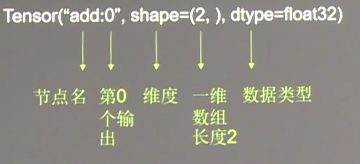tensor 即张量,是 tf 的核心数据结构,它可以是一个标量、向量、矩阵、多维数组
基本属性
Tensor 有 3 个基本属性
d2 = tf.constant([1., 2.]) print(d2) # Tensor("Const:0", shape=(2,), dtype=float32)
解释如下

节点名:输出:Tensor 是节点的输入和输出,节点就是操作 op,上图中 add 就是一个 op,代表这个 Tensor 是 add 操作的输出
这点很重要,用来判断是不是 操作op
数据格式:tf.string、tf.float32、tf.int16、tf.int32、tf.complex64(复数)、tf.bool 等
基本属性可直接获取,无需 Session
d1 = tf.ones((2, 3)) ## 直接获取属性,无需 session print(d1) # Tensor("ones:0", shape=(2, 3), dtype=float32) print(d1.shape) # (2, 3) print(d1.dtype) # <dtype: 'float32'>
shape
值得注意的是第二个属性 shape,它和 numpy 中的 shape 是一样的
先看个例子:
d2 = tf.constant([1., 2.]) print(d2) # Tensor("Const:0", shape=(2,), dtype=float32) ### 我们发现 shape 并不是 (1, 2) #### vs numpy d3 = np.array([1, 2]) print(d3.shape) # (2,) ### numpy 的 shape 与 Tensor 的 shape 一致
跟我们理解的 shape 略有不同,其实 shape 是这样的,
shape 中 元素的个数 代表 Tensor 的维度,或者说阶数,每个元素的值 代表 这个维度上的 长度;
# shape=(100,784) 代表该张量有两个维度,第一个维度长度为100,第二个维度长度为784,二维数组100行784列; # shape=(2,) 代表该张量有一个维度,第一个维度长度为2,一维数组1行2列
再看个例子:
d4 = tf.constant([[[1, 1, 1, 1], [2, 2, 2, 3]], [[3, 3, 3, 3], [4, 4, 4, 4]]]) print(d4) # Tensor("Const_1:0", shape=(2, 2, 4), dtype=int32) #### vs numpy d5 = np.array([[[1, 1, 1, 1], [2, 2, 2, 3]], [[3, 3, 3, 3], [4, 4, 4, 4]]]) print(d4.shape) # (2, 2, 4) ### numpy 的 shape 与 Tensor 的 shape 一致
其实对于高维数组来说,shape 就是矩阵的形状,如
[[[1,2,3],[4,5,6]]] # 第一个维度中只有一个元素[[1,2,3][4,5,6]],所以第一个维度长度为1 # 第二个维度中有两个元素[1,2,3][4,5,6],所以第二个维度长度为2 # 第三个维度中有三个元素“1,2,3”或“4,5,6”,所以第三个维度长度为3 # 那么它的shape参数就是[1,2,3]
注意:形状不一定在编译时确定,可以在运行是通过推断得出
阶数:Tensor 的维度
阶数的获取需要 session
示例
d1 = tf.ones([3, 2]) n1 = tf.rank(d1) print(n1) # Tensor("Rank:0", shape=(), dtype=int32) 阶数 不可直接获取,需要 session d2 = tf.constant([[[1, 1, 1, 1], [2, 2, 2, 3]], [[3, 3, 3, 3], [4, 4, 4, 4]]]) n2 = tf.rank(d2) with tf.Session() as sess: print(sess.run(n1)) # 2 阶张量 print(sess.run(n2)) # 3 阶张量
tf 中有几种比较特别的张量
tf.constant 常量
tf.Variable 变量
tf.placeholder 占位符
他们都具有 Tensor 的属性
常量
注意几点:
1. 不同类型的常量不能运算
2. 常量可像 python 变量一样直接赋值
def constant(value, dtype=None, shape=None, name="Const")
示例
### 单个元素 d1 = tf.constant(1) d2 = tf.constant(2, dtype=tf.int32, name='int') d3 = tf.constant(3., dtype=tf.float32, name='float') d4 = tf.add(d1, d2) # d5 = d1 + d3 ### 不同类型的数据不能运算 d6 = d1 + d2 sess1 = tf.Session() print(sess1.run(d4)) # 3 # print(sess1.run(d5)) ### 报错 type float32 does not match type int32 print(sess1.run(d6)) # 3 print(type(d6)) # <class 'tensorflow.python.framework.ops.Tensor'> ### 矩阵 d1 = tf.constant([[1., 2.]]) d2 = tf.constant([[2.], [3.]]) d3 = tf.matmul(d1, d2) ## 常数赋值 d2 = d1 sess2 = tf.Session() print(sess2.run(d3)) # [[8.]] print(sess2.run(d2)) # [[1. 2.]]
参考资料:





【推荐】国内首个AI IDE,深度理解中文开发场景,立即下载体验Trae
【推荐】编程新体验,更懂你的AI,立即体验豆包MarsCode编程助手
【推荐】抖音旗下AI助手豆包,你的智能百科全书,全免费不限次数
【推荐】轻量又高性能的 SSH 工具 IShell:AI 加持,快人一步
· AI与.NET技术实操系列:向量存储与相似性搜索在 .NET 中的实现
· 基于Microsoft.Extensions.AI核心库实现RAG应用
· Linux系列:如何用heaptrack跟踪.NET程序的非托管内存泄露
· 开发者必知的日志记录最佳实践
· SQL Server 2025 AI相关能力初探
· 震惊!C++程序真的从main开始吗?99%的程序员都答错了
· winform 绘制太阳,地球,月球 运作规律
· 【硬核科普】Trae如何「偷看」你的代码?零基础破解AI编程运行原理
· 上周热点回顾(3.3-3.9)
· 超详细:普通电脑也行Windows部署deepseek R1训练数据并当服务器共享给他人
2019-02-24 循环神经网络(三)-RNN进阶
2019-02-24 卷积神经网络CNN【1】-简介